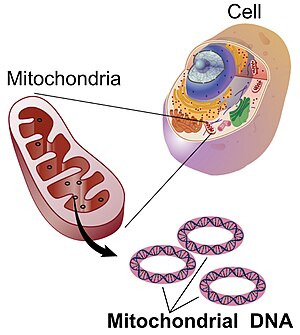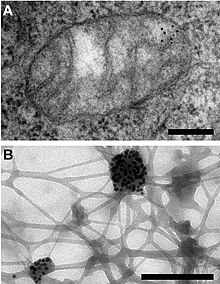
Back Mitochondriale DNS Afrikaans دنا متقدرة Arabic Мітахандрыяльная ДНК Byelorussian Митохондриална ДНК Bulgarian Mitohondrijska DNK BS ADN mitocondrial Catalan Mitochondriální DNA Czech Mitokondrielt DNA Danish Mitochondriale DNA German Μιτοχονδριακό DNA Greek


Mitochondrial DNA (mtDNA and mDNA) is the DNA located in the mitochondria organelles in a eukaryotic cell that converts chemical energy from food into adenosine triphosphate (ATP). Mitochondrial DNA is a small portion of the DNA contained in a eukaryotic cell; most of the DNA is in the cell nucleus, and, in plants and algae, the DNA also is found in plastids, such as chloroplasts.[3]
Human mitochondrial DNA was the first significant part of the human genome to be sequenced.[4] This sequencing revealed that human mtDNA has 16,569 base pairs and encodes 13 proteins. As in other vertebrates, the human mitochondrial genetic code differs slightly from nuclear DNA.[5]
Since animal mtDNA evolves faster than nuclear genetic markers,[6][7][8] it represents a mainstay of phylogenetics and evolutionary biology. It also permits tracing the relationships of populations, and so has become important in anthropology and biogeography.
- ^ Siekevitz P (1957). "Powerhouse of the cell". Scientific American. 197 (1): 131–40. Bibcode:1957SciAm.197a.131S. doi:10.1038/scientificamerican0757-131.
- ^ Iborra FJ, Kimura H, Cook PR (May 2004). "The functional organization of mitochondrial genomes in human cells". BMC Biology. 2: 9. doi:10.1186/1741-7007-2-9. PMC 425603. PMID 15157274.
- ^ Sykes B (10 September 2003). "Mitochondrial DNA and human history". The Human Genome. Wellcome Trust. Archived from the original on 7 September 2015. Retrieved 5 February 2012.
- ^ Anderson S, Bankier AT, Barrell BG, de Bruijn MH, Coulson AR, Drouin J, et al. (April 1981). "Sequence and organization of the human mitochondrial genome". Nature. 290 (5806): 457–465. Bibcode:1981Natur.290..457A. doi:10.1038/290457a0. PMID 7219534. S2CID 4355527.
- ^ Chinnery, Patrick Francis; Hudson, Gavin (June 2013). "Mitochondrial genetics". British Medical Bulletin. 106 (1): 135–159. doi:10.1093/bmb/ldt017. ISSN 0007-1420. PMC 3675899. PMID 23704099.
- ^ Boursot P, Bonhomme F (1 January 1986). "[Not Available]". Génétique, Sélection, Évolution. 18 (1): 73–98. doi:10.1186/1297-9686-18-1-73. PMC 2713894. PMID 22879234.
- ^ Delsuc F, Stanhope MJ, Douzery EJ (August 2003). "Molecular systematics of armadillos (Xenarthra, Dasypodidae): contribution of maximum likelihood and Bayesian analyses of mitochondrial and nuclear genes". Molecular Phylogenetics and Evolution. 28 (2): 261–275. Bibcode:2003MolPE..28..261D. doi:10.1016/s1055-7903(03)00111-8. PMID 12878463. Archived from the original on 4 November 2018. Retrieved 4 November 2018.
- ^ Hassanin A, An J, Ropiquet A, Nguyen TT, Couloux A (March 2013). "Combining multiple autosomal introns for studying shallow phylogeny and taxonomy of Laurasiatherian mammals: Application to the tribe Bovini (Cetartiodactyla, Bovidae)". Molecular Phylogenetics and Evolution. 66 (3): 766–775. Bibcode:2013MolPE..66..766H. doi:10.1016/j.ympev.2012.11.003. PMID 23159894.